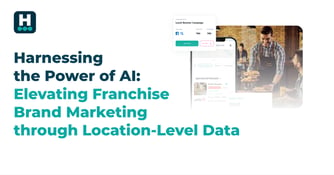Harnessing the Power of AI: Elevating Franchise Brand Marketing through Location-Level Data
In today's digital era, franchise brands face the unique challenge of balancing centralized...

The restaurant industry has been one of the most greatly impacted sectors affected by the pandemic. If you’re a restaurant owner who was fortunate enough to have survived the past year, now you’re faced with another recovery challenge: finding restaurant staff.
The media has evolved from sharing stories of suffering out of work restaurant staff to struggling business owners trying to recruit new or returning workers. QSR magazine recently reported that 40 percent of restaurants said they’re “severely understaffed.”
As restrictions are easing, restaurant demand is increasing, but so is the abundance of available restaurant industry jobs. While the restaurant industry lost 2.5 million jobs in 2020, Q1 2021 opened up 442,000 positions. Staff that had been previously furloughed, laid off, or departed the industry altogether due to the pandemic, are now in great demand. Every type of establishment is facing the same situation, so there are often hundreds – if not thousands -of available restaurant jobs in one geographic area
Restaurant Staffing is a Universal Problem
From major cities to small suburbs, fast food to fine dining, restaurants of all types and sizes are facing the same issues. Since the pandemic, many people have left the industry for a more secure job market, while others fled tightly restricted cities for those with fewer public health mandates. Some career restaurant workers left high-cost cities, like New York, for areas with a more affordable cost of living. People want to get back to work, but unemployment checks and increased benefits have made them slow to return to restaurant jobs, as it is often more lucrative to stay home.
Franchise Businesses’ Unique Challenge
Franchise brands are faced with not only a lack of employees for current locations, but the staffing shortage has stopped the growth of the entire organization. If you can’t hire people for existing locations, how can you expand into new ones? This not only impacts the entire franchising model but prohibits the business opportunity for new potential franchisees.
See how the staffing issue is impacting the franchise business model.
A 200 outpost Italian restaurant chain in the Midwest, Fazoli’s has relaxed many of its franchising requirements, including upfront costs, to entice new franchisors. Taco Bell held a hiring event to hire 5,000 employees in one day and increased their benefits package for general managers to 4 weeks of paid vacation and 8 weeks of paid maternity leave. There were still 49,000 jobs open on their website at the time. A Florida McDonald’s franchisee offered candidates $50 each just to show up for an interview. One Subway owner has offered a $300 signing bonus and a $2 per hour increase to new hires.
A New Way to Hire
With the quality and number of workers spread thin, and jobs in abundance, restaurants need to seek out alternative methods to hire than they’ve ever embarked on before. “Now Hiring” signs in the window and printed job listings are no longer going to bring in dozens of applicants.
Justin Bartek, head of marketing at upscale ramen franchise JINYA Ramen Bar is approaching hiring as he does the rest of the brand’s local marketing, but instead of attracting new customers, he’s seeking to convert new staff members. Bartek is using local digital advertising to recruit job candidates.
“We want to look out for our operators and are trying to think of anything we can do to help them,” says Bartek. “We wanted to offer this option to our operators so they can participate in the local recruiting efforts and contribute towards local digital advertising. We’re leveraging what we know works to reach local customers to find local staff.” Bartek was voted as a Brand Innovator in the FSR Magazine Readers Choice Awards for his cutting-edge approach to brand engagement.
Specialized Martech platforms, like Hyperlocology, offer a centralized way to hire that multi-location restaurants didn’t have before. Previously, the GM would have to collect emails and try to organize it all manually. Now, the recruiting ad leads to a landing page with a form that collects all candidate data into a downloadable list or in real-time on the platform. Marketing technology enables brands to recruit the best employees.
Every restaurant location has distinct hiring needs as well. Leveraging digital advertising, individual locations can create specific messaging targeted to the exact roles they are hiring for. For example, if you’re looking for a host, the ad copy can call out that job title and duties specifically to attract someone looking for that role.
Just as brands can leverage online data to attract the right target customer audience, the same digital advertising strategies can also be used to attract the best job candidates. When targeting employment campaigns, historic data from the best current employees can be used to set up recruitment ads to attract the best candidates. Using a martech platform to manage campaigns offers your brand multiple channel access to target audiences, from Facebook and Instagram, to display and Google.


In today's digital era, franchise brands face the unique challenge of balancing centralized...


You've heard it. We've heard it. Franchisees are always asking what levers they can pull to improve...